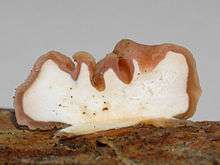Tremella encephala
| Tremella encephala | |
|---|---|
 | |
| Tremella encephala and its host, Stereum sanguinolentum | |
| Scientific classification | |
| Kingdom: | Fungi |
| Division: | Basidiomycota |
| Class: | Tremellomycetes |
| Order: | Tremellales |
| Family: | Tremellaceae |
| Genus: | Tremella |
| Species: | T. encephala |
| Binomial name | |
| Tremella encephala Pers. (1801) | |
| Synonyms | |
|
Tremella encephaliformis Willd. (1785) | |
Tremella encephala is a species of fungus producing pink, brain-like, gelatinous basidiocarps (fruit bodies). It is widespread in north temperate regions and is parasitic on another species of fungus (Stereum sanguinolentum), that grows on dead attached and recently fallen branches of conifers.
Taxonomy
Tremella encephala was first published in 1801 by Dutch mycologist Christiaan Hendrik Persoon, based on an earlier description by Carl Ludwig Willdenow who had described the species from Germany as Tremella encephaliformis. In 1818, it was selected by Elias Magnus Fries as the type species of Naematelia, a new genus proposed by Fries to accommodate fungi having gelatinous basidiocarps with a hard or compact core.[1] It was not until 1961 that this central core was shown by American mycologist Robert Bandoni to be the remains of the host fungus, Stereum sanguinolentum.[2]
The epithet encephala means "brain", with reference to the shape and colour of the basidiocarps.
Description

Fruit bodies are gelatinous, dull pale pink to yellowish pink, up to 3 cm (1 in) across, and brain-like (compact and densely folded) with a hard, whitish core when cut. Microscopically, the hyphae are clamped and occur in a dense gelatinous matrix. Haustorial cells arise on the hyphae, producing filaments that attach to and penetrate the unclamped hyphae of the host (abundant in the central core). The basidia are tremelloid (spherical to ellipsoid, with oblique to vertical septa), 13–20 by 12–17 μm, usually unstalked. The basidiospores are mostly roughly spherical in shape, smooth, 6–11 by 5.5–9 μm, and germinate by hyphal tube or by yeast cells.[2][3]
Habitat and distribution
Tremella encephala is a parasite of Stereum sanguinolentum, growing on and often completely enveloping host basidiocarps. Following its host, fruit bodies are typically found on dead, attached or recently fallen branches of conifers.[2][3]
The species has a north temperate distribution and is known throughout North America, Europe, and northern Asia.[2][3] It has also been recorded from Australia.[4]
References
- ↑ Fries EM. (1818). Observationes mycologicae 2 (in Latin). Copenhagen, Denmark: Sumptibus G. Bonnieri. p. 370.
- 1 2 3 4 Bandoni RJ. (1961). "The genus Naematelia". American Midland Naturalist. 66 (2): 319–328. doi:10.2307/2423032. JSTOR 2423032.
- 1 2 3 Roberts P. (1999). "British Tremella species II: T. encephala, T. steidleri & T. foliacea". Mycologist. 13 (3): 127–131. doi:10.1016/S0269-915X(99)80044-5.
- ↑ Australian Fungi Checklist http://www.rbg.vic.gov.au/dbpages/cat/index.php/fungicatalogue/name/11036